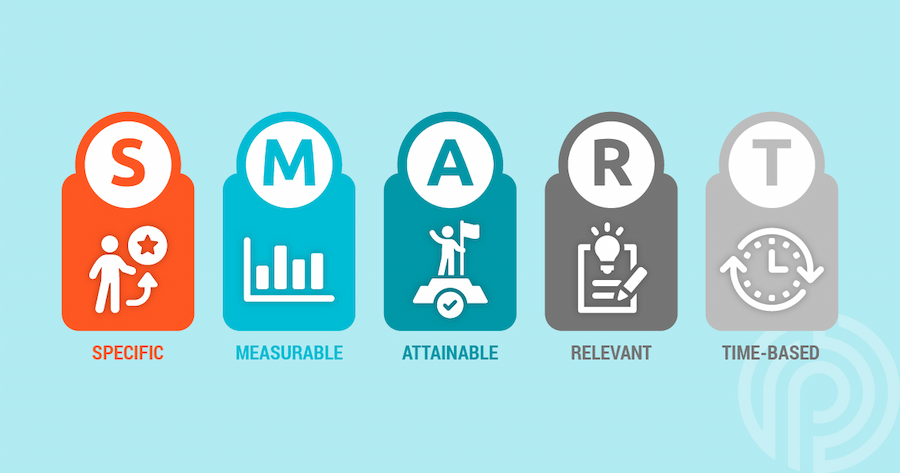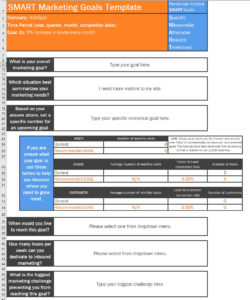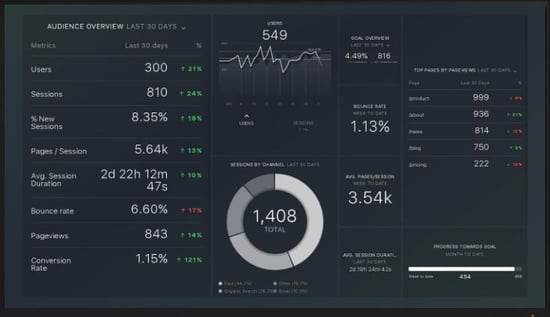
Written By:
Sean Henri
Marketing goals will provide a roadmap for your marketing efforts, further align your efforts with key business objectives, and allow you to stay motivated and easily measure your progress toward these goals.
Your marketing goals should be SMART goals, which are Specific, Measurable, Attainable, Relevant, and Time-based.
In this article, we will go over:
-
How SMART goals increase the likelihood that you will meet and exceed your goals.
-
Explain that to set SMART goals, you will first determine the appropriate metrics that you’re trying to improve upon.
-
How to use our free SMART goals template to create SMART marketing goals for your organization.
In any industry, establishing goals will provide you with a clear sense of direction, and can act as your strategic roadmap for what you should be focused on during your day-to-day job.
If you are managing a marketing team, it’s also imperative that you set goals for your department and each individual staff member. Going through this exercise will keep your team members focused, motivated, and accountable for their work.
It will also provide you, as the team lead, with a framework upon which you can measure your team’s impact and progress towards company-wide strategic goals.
In fact, a recent study found that you can become 42% more likely to achieve your goals and dreams simply by writing them down on a regular basis.
When done poorly, however, goal-setting can also have an undesired negative effect. Setting lofty goals like “let’s win a marketing award this year” or “let’s double our leads” can leave your team feeling overwhelmed and confused.
Download the S.M.A.R.T. Marketing Goals Template
An easy-to-use, free spreadsheet template with step-by-step instructions.
That’s where SMART Goals come in. SMART stands for Specific, Measurable, Attainable, Relevant, and Time-based. This framework keeps marketing goals much easier to digest and aligned with your business’s larger strategic objectives.
To help you align your marketing efforts with SMART goals, our friends at HubSpot built this easy-to-use marketing planning template, available for free, to download. It specifically helps you:
- Easily summarize your ultimate marketing goals
- Automatically calculate your greatest marketing need
- Set a deadline for meeting your annual, quarterly or monthly goals
What are SMART Goals?

SMART goals are documented goals that are specific, measurable, attainable, relevant and time-based. They help to ensure that goals are both strategic and invaluable, and can actually be achieved within a defined timeframe. Let’s break it down further:
- Specific – Make it crystal clear what you’re trying to achieve.
Instead of “increase leads,” try “increase marketing qualified leads for X service.”
Instead of “increase visitors,” try “increase visitors of X persona.”
- Measurable – This is how you know you’ve been successful. Use a metric that is the strongest indicator that you’re meeting your goal.
As an example, if your goal is to increase visitors, you should not report on pageviews since sessions or users would be a much more appropriate metric.
Bonus points if this metric is selected from a marketing scorecard that the entire team uses to measure success.
- Attainable– Use this as your gut check. Is this goal actually achievable within the period of time we’re measuring?
Goals should be ambitious, and difficult, but you don’t want to set your staff up for failure. You want your team to meet their goals.
- Relevant– Set goals that are tightly aligned with the overall strategy of the business and the goals of the department.
Avoid focusing on vanity metrics that might make the team feel good, but won’t help move the needle at the end of the day.
Try the CEO test. Would the CEO care if you met this goal? If not, then it might not be the right goal to work toward.
- Time-bound– Pick a date that you plan to achieve your goals by.
Is it by the end of Q1 or a year-end goal? Map this to your review cycle as you’ll want to be able to know if your direct report has met their goals when you sit down to meet.
If quarterly, it should represent a benchmark towards meeting a larger annual goal.
Examples of SMART Marketing Goals
The key when it comes to SMART goals is to remember that each one needs to connect back to your team's overall market strategy.
Below are a handful of SMART Goal examples that you can use as inspiration for yourself:
- In the next three months, I want to increase the number of organic sessions our blog receives by 10% so that we can grow our conversion funnel.
- I want to generate 10 leads from our blog in the next 30 days so that we can increase our revenue for the month.
- We want to publish 50 high-quality social posts for the quarter so that we can increase social engagements by 15%.
- We want to improve our Net Promoter Score (NPS) by 2 points from January 1st to March 31st so that we can increase customer loyalty for Q1.
Why Should Your Marketing Goals be SMART?
Motivational speaker Zig Ziglar said it best: “A goal properly set is halfway reached.”
By properly setting concrete goals for yourself and your team, you’re increasing the probability that you’ll meet and exceed these goals.
Think about two scenarios:
- During a meeting, Manager A tells their team “we need to increase traffic to our website.”
- Manager B sends a memo to each team member stating that they are responsible for writing 3 unique blog posts that will generate 1,000 website sessions each by the end of the quarter.
Which manager’s team is more likely to meet their goals? If you said Manager B, you’ve got it!
Manager A gave their team an extremely vague and ultimately useless goal. How are they supposed to increase traffic? By how much? And by when? Members of Team A have nothing to align their efforts with or measure their progress against because there is no clearly-defined end goal.
On the other hand, each member of Manager B’s team has a specific, measurable, attainable, relevant, and time-bound goal that will guide their content marketing efforts for the quarter. Since they were given well-defined SMART goals at the start of the quarter, they know what they should be doing and how to measure the success of their efforts.
By setting SMART goals, marketers can guarantee that their goals are well-aligned with key business objectives, while easily measuring their progress and success.
What Type of Metrics Are Best To Use for SMART Goals?
When defining your specific goal, you’ll need to have a certain metric in mind that you wish to improve. This could be the count of sales-ready leads you hope to generate, or the number of emails you’ll send on a monthly basis. Whatever it is, make sure that you focus on a metric that is closely tied to your core responsibility, and that is a positive improvement
Before selecting a metric to measure your goal by, it might be helpful to establish two different categories of metrics: KPIs and Leading Indicators. A KPI, or key performance indicator, is a metric that should instantly tell you if you’ve made progress towards a primary, strategic goal.
Examples of common KPIs might include:
- Number of visitors
- Number of leads generated
- Conversion rate
- Revenue per customer
- Revenue per deal
A leading indicator is a metric or trend that could indicate that you’re on track to meeting your KPI. For example, if one of your KPI’s is the # of MQL’s generated from social media, social followers, retweets, or social click-through-rate might be leading indicators to pay attention to.
When selecting a metric to focus on for a SMART goal, you’ll generally want to choose a KPI over a leading indicator unless it is tied to a specific lever you need to pull to improve your KPI performance. If your selected metric isn’t directly tied to revenue growth, and you create a goal around something like Facebook Likes, your boss might think you’re focusing on the wrong types of activities.
It’s also wise to take into consideration your role in the organization. If you are an individual contributor and not in management, you might not be able to directly influence something like total revenue generated by your actions alone, and therefore it is unfair to hold yourself to that metric in a SMART goal. Instead, focus on a metric that you do have the influence and skills to reach on your own, which if achieved will help the team meet their more strategic-level goals.
If the SMART goal is for a department head or senior manager, it is much more appropriate to hold them to a KPI metric such as total new business revenue generated.
Using The Free SMART Goal-Setting Template
This template will help you clearly describe your goals, set a deadline for meeting them, and understand the desired end result. It has been customized for the common needs of marketers, and helps improve the likelihood you’ll meet your goals by forcing you to identify potential obstacles up-front.
You’ll want to collaborate on each input so there is full agreement and no confusion. Once you’ve established and agreed upon the goals, find a way to track your progress. Tools like Databox allow you to track your SMART goals automatically.

Using this template will give you a clear view of all the SMART marketing objectives that are essential to your business' success. With your goals set and solid dashboards in place, you'll be able to schedule weekly check-ins to discuss progress and address any obstacles that come up along the way.








